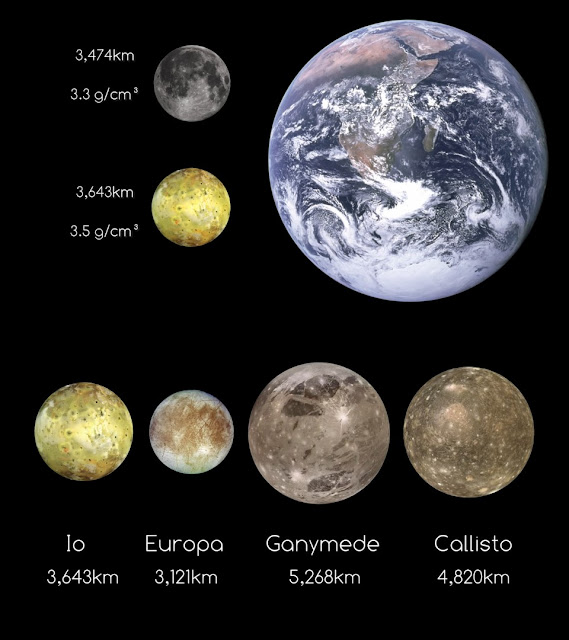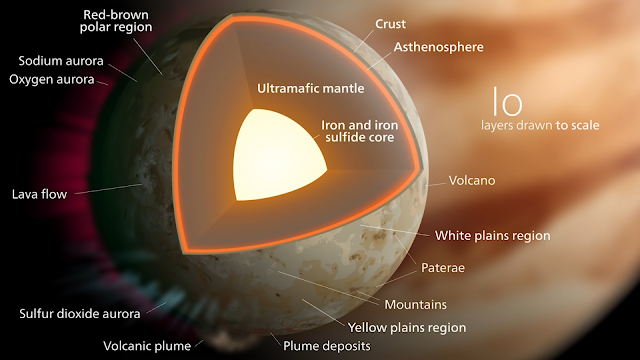‘Jupiter’ has 79 moons that we know of so far, few of them are innermost moons that orbit closer to the planet and beyond these moons there are four large moons of Jupiter which are known as Galilean Moons named after astronomer Galileo who discovered them in 1610, innermost to outermost these four moons are Io, Europa, Ganymede and Callisto.
 |
| Four Galilean Moons |
Beyond Galilean moons there are irregular moons of Jupiter all of which are much further out than the previous moons. ‘Io’ orbits very close to the Jupiter which is only 350,000 kilometers above Jupiter’s cloud tops and this means from Io’s surface, Jupiter would appear 39 times bigger in the sky than our moon from Earth’s surface. ‘Io’ orbits Jupiter in only 42.5 Earth hours compared to our moon’s monthly orbit. Io’s orbit is actually in sync with two of the other Galilean moons, it orbits twice for every one orbit of Europa and four times for every orbit of Ganymede and this is what we call an Orbital Resonance.
Orbital Resonances greatly enhance the mutual gravitational influence of the moons which means gravitational forces from other moons cause the orbit of ‘Io’ to have a little more eccentricity and this is likely the primary heat source for most of the Io’s geological activities as Jupiter’s gravity pulls and tugs on Io causing tidal heating. At some point in Io’s orbit the tidal bulge on it is thought to be up to 100 meters, this effect is similar to what we see on Earth with the oceans tides being caused by the moon although on Earth the effect is much more minimal with the tides usually shifting only about 2 meters from high to low.
‘Io’ is getting 300% more tidal force exerted on it in comparison to our moon on us because of it’s close proximity to the biggest planet in the solar system the Jupiter and other big moons in the system do not allow the moon’s orbit to be any less eccentric and that means Io is not gonna be getting any rest by it anytime soon. A day on ‘Io’ is same as it’s orbital rotation which means that ‘Io’ is tidally locked with Jupiter just like we can only see one face of our moon from Earth, only one face of ‘Io’ can ever be seen from Jupiter.
‘Io’ is pretty big moon although it is second smallest out of the Galilean moons, it is actually comparable in size to Earth’s moon and shares a similar density which means it has similar amount of gravity, but interestingly is does have the highest density of any other moon in the solar system, one of it’s many unique features another is that it is composed mainly of silicate rock and iron similar to the terrestrial planets and our moon in comparison to most other big moons in solar system which are made mostly of water ice and silicates, ‘Io’ in fact has the least amount of water of any known body in the entire solar system.
Io’s core is likely to be made of iron or iron sulphides surrounded by silicate rich mantle and crust, the core is not thought to be convecting them as no magnetosphere has been detected around the moon, the mantle is thought to be liquid near the crust and is at least 50 kilometers thick which is where all the volcanism originates. The most interesting part of Io is perhaps the hundreds of huge volcanos all over it’s surface, before the 1970’s we did not know much about Io at all although the telescopes were starting to pick up hints about this fascinating moon, the first mission to see Io in any kind of detail was Pioneer-11, although the quality was still not great but what it did detect however is that Io was made of silicate rock and not water ice and that it has thin atmosphere.
Pioneer-10 was also meant to take some close up shots of ‘Io’ but this was lost due to Jupiter’s radiation interfering with the on board command system, the radiation Pioneer-10 went through was 10,000 times stronger than the maximum radiation around the Earth. The next missions to Jupiter were the Voyager 1 and 2 missions in 1979, Voyager-1 flew by at a distance of only 20,000 kilometers and was able to take some impressive close ups of Io’s surface, what it saw was remarkable landscape, full of vibrant colors and total absence of impact crators, it found mountains taller than Everest as well as volcanic pits hundreds of kilometers wide and what looked to be lava flows, most notably however was the presence of flumes coming from the surface and this proved that the ‘Io’ was volcanically active. Voyager-1 also confirmed that the surface of ‘Io’ is covered in different compounds of sulfur and allotropes, this is what gives Io it’s many spectacular colors and it is found that it is these sulfur compounds that dominate Io’s atmosphere.
Voyager-2 also saw ‘Io’ in July of 1979 but was much further away at 1 million kilometers, although it still saw 7 of the 9 flumes that Voyager-1 saw in March of 1979, which meant those volcanos likely remained active throughout those four months, even the Galileo spacecraft took some high resolution images of Io when it arrived at Jupiter in 1995, it also saw flumes from many volcanos as well as it confirmed that the volcanos were erupting sulfur and silicate manganese similar to what we have on Earth except the magma on ‘Io’ is also rich in magnesium.
The surface of ‘Io’ is spectacularly colorful, the yellow plains are composed of mostly sulfur, the white areas are mainly fresh sulfur dioxide compounds and towards the poles the sulfur is damaged by radiation which can be seen as the poles appear redder than the rest of the moon, in other places the colors of red are the deposits left by the volcanic flumes that reached hundreds of kilometers above Io. This fascinating and mysterious moon is still hiding many of the exciting aspects to be discovered in the near future.





